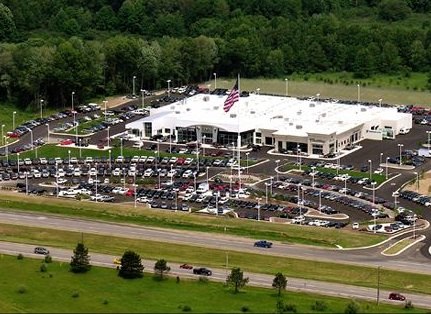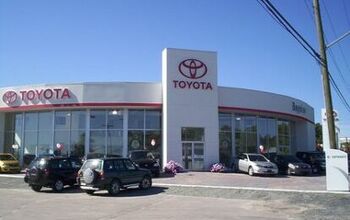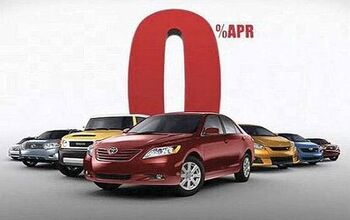GM Vs. Toyota Dealer Costs
One of our Best and Brightest pointed us to these “back of the envelope” calculations on the relative costs of running GM’s dealer network. [The comment was originally posted on the DealersEdge website. We’ve republished it here with the author’s permission.]
In a very limited attempt to figure out the savings, I’ve come up with a quickie comparison of just the cost of “reps”, with a number of assumptions. Comparing GM and its 6400 dealers to Toyota and their 1200 dealers (both of which sell almost the same amount of cars). Assuming 2 Reps (one Sales one Fixed) for every 10 dealers (for both manufacturers) and a 1:10 ratio for Supervisory positions of those reps (for both manufacturers) and for the sake of easy calculations, assume 100K Salary average for everyone.
Toyota:
1200 Dealers
GM
Total Dealer support staff = 1422 @ 100K per = $142,200,000 Annually
If you take that number of 142 million and divide it by the 6400 dealers, than the field support expense for GM per dealer per year is $22,218, which doesn’t sound like much does it?
If you look at the difference in “field support” expense between GM and Toyota on a nationalized basis, there is a difference of $79,500,000 per year.
When you consider that GM has an additional $80 million per year in “field staff” expenses to sell almost the same number of units, I can see how a bunch of suits in an ivory tower can come to this decision. There seems to be an assumed belief though, that if GM reduces its dealer count, it will still sell the same number of units. I think that belief is the “Wild-Card” thought though, and unfortunately, no one will know the reality until the dealerships are in fact closed.
There are other savings, by fewer dealers, in shipping.
If you assume every dealer gets one truck delivery per day (be it vehicles or parts) and just for easy math, lets assume $500 per truck delivery (not the cost of the vehicles or parts themselves) (for both manufacturers)
GM – 6400 Dealers X 5 Deliveries per Week X 500 per Delivery X 52 Weeks = $832,000,000
This represents a per dealer cost of $130,000 per year
Toyota – 1200 dealers- same deliveries and cost per = $156,000,000 Annually
Again, assuming a nationalized number, it costs GM $676,000,000 more per year. Even cutting the dealer count almost in half, and GM will still have a higher expense than Toyota. Using the 22K per dealer avg for field staff and 130K per dealer avg for shipping, these 2 expenses alone represent a 150K per year per Dealer cost reduction for each dealer they shut down.
GM stated an objective of having 3600 dealers remaning, which means they intend to close roughly 2800 dealers. So 2800 dealers closed X 150K per year cost reduction = 420,000,000 per year in cost reduction X a conservative 5 years = $2,100,000,000. So over 5 years, the dealer count reduction to 2800 reduces GM’s expense (on these 2 expenses) by just over $2b.
I am sure there are other areas where savings can occur, but only a bunch of accountants could figure out all that math. But let’s assume another 2 billion over 5 years saved from that, for a total of 4 billion saved over 5 years.
At that rate, assuming no interest charges, it will take 20 years to pay back the money loaned to GM by the United States & Canadian Taxpayers!
More by Robert Farago
Latest Car Reviews
Read moreLatest Product Reviews
Read moreRecent Comments
- V8fairy Not scared, but I would be reluctant to put my trust in it. The technology is just not quite there yet
- V8fairy Headlights that switch on/off with the ignition - similar to the requirement that Sweden has- lights must run any time the car is on.Definitely knobs and buttons, touchscreens should only be for navigation and phone mirroring and configuration of non essential items like stereo balance/ fade etc>Bagpipes for following too close.A following distance warning system - I'd be happy to see made mandatory. And bagpipes would be a good choice for this, so hard to put up with!ABS probably should be a mandatory requirementI personally would like to have blind spot monitoring, although should absolutely NOT be mandatory. Is there a blind spot monitoring kit that could be rerofitted to a 1980 Cadillac?
- IBx1 A manual transmission
- Bd2 All these inane posts (often referencing Hyundai, Kia) the past week are by "Anal" who has been using my handle, so just ignore them...
- 3-On-The-Tree I was disappointed that when I bought my 2002 Suzuki GSX1300R that the Europeans put a mandatory speed limiter on it from 197mph down to 186mph for the 2002 year U.S models.


































Comments
Join the conversation
The assumptions made in this comparison are SO OFF-BASE AND WRONG. As a GM dealer, we sell under 300 new and XXX used per year. The factory reps call on us by telephone, e-mail and internet contact. We have not had a GM employee in the dealership for over four years. Our reps/ both sales and service are responsible for forty five dealers and I can assure you that they don't make 100K per year. Keep dreamin guys. The dealers aren't the problem. Let the market take care of this and it will. This heavy handed approach will only make matters worse. TYPICAL GOVERNMENT SOLUTION
[...] permalink Originally Posted by clonefarmer How does closing half of its dealerships save GM all that much money? I see lower administrative costs, of course, but won't there be plenty of lawsuits to contend with? This does a good job of breaking it down. GM vs. Toyota Dealer Costs | The Truth About Cars [...]